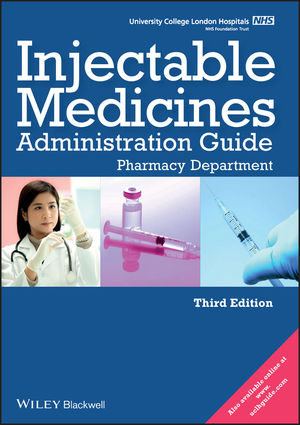UCL Hospitals Injectable Medicines Administration Guide: Pharmacy Department, 3rd EditionISBN: 978-1-4051-9192-0
Spiral-bound paperback
348 pages
October 2010, Wiley-Blackwell
 |
||||||
Third edition editorial board viii
Contributors ix
Acknowledgements x
Preface xi
Section A 1
1 Introduction 1
2 Overview 2
2.1 Organisation of information in the Guide 2
2.2 Sources of information and disclaimer 3
3 UCLH policies 4
3.1 Responsibilities of professional staff at UCLH 4
3.2 Preparation of injectable medicines on wards, clinics and departments at UCLH 5
4 An overview of intravenous therapy 6
4.1 When is intravenous therapy appropriate? 6
4.2 Drug factors that influence the choice of route 7
4.3 Disadvantages of intravenous administration 8
4.4 Routes of intravenous administration 9
5 Factors affecting patency of intravenous sites 11
5.1 Factors increasing failure of intravenous sites 11
5.2 Factors decreasing failure of intravenous sites 11
5.3 Occlusion of central venous catheters 11
6 Methods of intravenous administration 12
6.1 Intravenous bolus 12
6.2 Intermittent intravenous infusion 13
6.3 Continuous intravenous infusion 13
6.4 Preparation and administration of intravenous medicines 14
6.5 Aseptic non-touch technique (ANTT) 15
7 Extravasation of injectables: overview and management advice 17
7.1 Patient factors affecting extravasation 17
7.2 Medicine factors affecting extravasation 17
7.3 Administration factors affecting extravasation 21
7.4 Overall risk for extravasation 21
7.5 Treatment of extravasation 21
8 Flushing cannulae, catheters and administration sets 24
8.1 Flushing between medicines 24
8.2 When not to flush 24
8.3 Flushing catheters and cannulae not in use 25
8.4 Flushing with heparin 25
9 Infusion pumps 26
9.1 Pumps used at UCLH 26
9.2 Volumetric pumps 26
9.3 Syringe pumps 26
9.4 Pumps for ambulatory use 27
9.5 Patient-controlled analgesia (PCA) pumps 27
9.6 Target-controlled anaesthesia (TCI or TIVA) pumps 28
10 Administration of injectables in primary care 29
10.1 Self-caring patients 30
11 Formulation and presentation of injectables 31
11.1 Medicines that require reconstitution 31
11.2 Preparations in solution requiring further dilution before use 32
11.3 Preparations available ‘ready to use’ without further dilution 32
11.4 Preparations available ‘ready to administer’ 32
12 Pharmaceutical aspects of injectable administration 34
12.1 Displacement values 34
12.2 Sodium content 34
12.3 Drop size 35
12.4 Layering 35
12.5 Fluid restriction 35
13 Factors influencing medicine stability and compatibility of injectable medicines 37
13.1 Degradation 37
13.2 Precipitation 38
13.3 Binding of medicines to plastics 38
13.4 Destabilisation of parenteral emulsions 39
13.5 Leaching of plasticisers 39
13.6 Blood and blood products 40
14 Allergic reactions to injectables 41
14.1 Latex allergy 41
15 Compatibility of drugs in a syringe driver for subcutaneous use 43
16 Risk assessment of injectables and risk reduction 45
16.1 Risk assessment 45
16.2 Risk reduction 47
17 Useful resources 49
17.1 Websites 49
17.2 Further reading 50
Section B 51
User guide 51
Monographs in alphabetical order 67
Index of monographs 333



